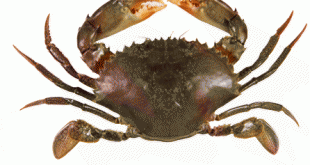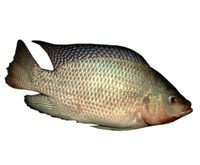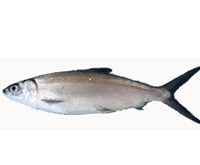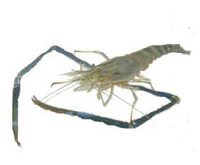Why shrimp culture?
- New technology on shrimp farming in brackishwater ponds
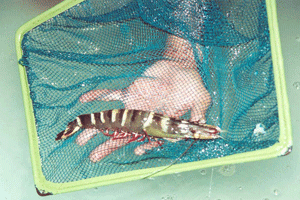 incorporates pollution management
incorporates pollution management - Could be integrated with commodities such as tilapia, bivalve, seaweed
- Environment-friendly techniques, like crop rotation and improvement of feed formulation can be employed
- Greenwater technology makes it possible to inhibit disease-causing organisms
| Technological Viability | |
| Penaeid Shrimp Hatchery
|
|
| Brackishwater Pond Culture
|
| List of Technology Adoptors | |
| Penaeid Shrimp Hatchery
• Most barangay or backyard, medium and large-scale shrimp hatcheries in the country (beginning the 1980s) Brackishwater Pond Culture of Black Tiger Shrimp • Country-beneficiaries of SEAFDEC’s region-wide mangrove-friendly aquaculture program (e.g., Yangon, and Kyauktan, Myanmar; 2002; the Marine Shrimp Research and Development Institute of the Department of Fisheries, Thailand; the Dumangas Brackishwater Station of SEAFDEC/AQD, Iloilo, Philippines; Johor, Malaysia (2004)) – An off-season shrimp operation was conducted in the Dumangas station of AQD to determine the efficacy of commercially available probiotics using a 0.89-hectare pond and a stocking density of 15 pieces per sq. m. – The Environment-Friendly Schemes in Shrimp Farming Technology was implemented in Johor, Malaysia utilizing two ponds measuring 2,500 sq. m. One pond was stocked at 25 pieces per sq. mm while the other pond with 15 pieces per sq. m. Feeds and additives from Thailand were used. – Another demonstration and on-site training of the mangrove-friendly shrimp aquaculture was conducted under the auspices of the MFSCP and the ASEAN Program in Myanmar. Five understudies from the Department of Fisheries were trained. • BFAR regional sites (e.g., Botong, Taal, Batangas and Pacita, Lala, Lanao del Norte; beginning 2002; in a project with SEAFDEC/AQD on the Joint Mission for Accelerated Nationwide Technology Transfer Program (JMANTTP) – A total of four ponds were used for the demo project. Two ponds, each with an area of 4,000 sq. m were used as grow-out ponds while the other two ponds served as reservoir and treatment pond at the same time to provide the water requirements of the grow-out ponds. Shrimps were stocked at a density of 15 pieces per sq. m in the project located in Lala, Lanao del Norte. – Another demonstration was conducted in Taal, Batangas, utilizing a 2,000-sq.-m-pond with a stocking density. • Karen Fish Farm, Banate, Iloilo – The semi-intensive shrimp culture was demonstrated in tis farm, with a pond area of 7,000 sq. m. • Siochi Farm, Nasugbu, Batangas (2002) – The farm was the first private fish farm to benefit from the shrimp farming technology of the JMANTTP. It adapted the partial/low discharge system using environment-friendly schemes in three culture ponds. Shrimp stocking rate was 25. • Ledesma Fish Farm, Silay City, Negros Occidental (2002) – Two compartments from the farm, measuring 6,500 sq. m each, have been designated as reservoir and grow-out. • Rovira Fish Farm, Cabanbanan, Oton, Iloilo – After the MOA signing, preparations for stocking the grow-out pond measuring 9,000 sq. m with the 4,000 sq. m reservoir pond in the farm was started. • Cordero Fish Farm, Cabanbanan, Oton, Iloilo (2002) – Four ponds from the farm was used for the project; two ponds, each with an area of 5,000 sq. m were used for grow-out, while the other compartments served as reservoir. Pond preparation and management followed the protocol for semi-intensive. • Mercado Fish Farm, Bulacan (2004) – One culture run of the Environment-Friendly Schemes in Shrimp Farming Technology was implemented in the farm. It was conducted in DBS in ponds measuring 8,782 sq. m and 8,016 sq. m, using a stocking density of 25 shrimps per sq. m. • Asian Agronomics Incorporated, conducted in SEAFDEC/AQD Dumangas Brackishwater Station (2004) – The company requested AQD to test its probiotic and organic fertilizer product. After completion of the protocol of the pre- culture period, good quality shrimp fry were stocked at 25 pieces per sq. m. • Victor Buenaflor Fish Farm Corporation, Sabang, Surigao City (2004) – After experiencing several failures in the past, the company asked for a technology verification and transfer run of the Environment-Friendly Schemes in Shrimp Farming Technology. The culture pond, measuring 9,000 sq. m, was stocked with shrimp fry at a density of 28.9 pieces per • RETCEM Resources, Inc. Dumangas, Iloilo – For their second year of shrimp farming operation, RETCEM directly employed AQD staff to attend to three shrimp ponds, each with an area of 8,000 sq. m. The ponds were stocked at a density of 25 pieces per sq. m. |
|
| AQD’s Work on Shrimp |
| Way back in 1975, AQD was the first to complete the life cycle of tiger shrimp in captivity by eyestalk ablation. In 1977, spawners were produced by ablation of wild-caught broodstock held in marine pens, and fry were mass-produced in small-scale barangay hatcheries. The first of AQD’s training courses in tiger shrimp hatchery and grow-out was also in 1977. By 1978, AQD produced the first manual on barangay hatchery, and 1978 was considered to be the year when shrimp hatchery technology was transferred to the commercial private sector. Hatchery-reared fry was first stocked in ponds in 1979.
At present, AQD’s shrimp R&D is focused on the production of pond-reared broodstock of Penaeus monodon and P. indicus / P. merguiensis which will later be selected for desirable characteristics, particularly disease resistance, through an effective breeding program. In 1986, soft-shell syndrome in tiger shrimp in ponds can be controlled by a cost-effective diet that AQD formulated. In 1990, a cost-effective diet for grow-out culture was formulated. In 2001, AQD developed the protocol and standard for WSSV (white spot syndrome virus) diagnostics, and it is currently the reference laboratory for this. Regarding luminous bacteria that had so devastated shrimp grow-out culture, the latest studies at AQD have shown that in a greenwater system, there are beneficial organisms such as species of fungi like Candida, Mycelia, Sterilia, Rhodotorula, Saccharomyces that produce metabolites with inhibitory effects on the luminous bacteria. Skin mucus from tilapia, rabbitfish, seabass, snapper, milkfish, and grouper has also these metabolites and are thus bactericidal. A more integrated disease manual was published in 2000, as well as a textbook on fish health management in 2001. SEAFDEC with the ASEAN Fisheries Consultative Group embarked on environment-friendly schemes in tiger shrimp culture. Results of the collaboration were published as state-of-the-art series in 2000 and 2002. The technology is best described as low-discharge system, closed-recirculating shrimp farming and/or mangrove-friendly shrimp farming. |
 SEAFDEC/AQD Southeast Asian Fisheries Development Center | Aquaculture Department
SEAFDEC/AQD Southeast Asian Fisheries Development Center | Aquaculture Department
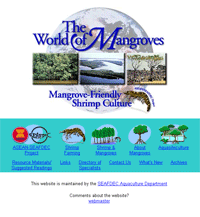
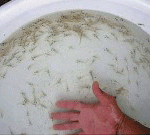 Separating spawners from the eggs will decrease chances of bacterial and fecal contamination, and is part of disease prevention techniques in hatcheries. Regular water replacement dilutes the concentration of toxic metabolites in the tank and decreases the stress factors.
Separating spawners from the eggs will decrease chances of bacterial and fecal contamination, and is part of disease prevention techniques in hatcheries. Regular water replacement dilutes the concentration of toxic metabolites in the tank and decreases the stress factors. 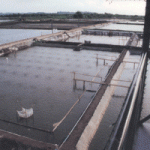 Shrimp culture loads a lot more nutrients from feeding and high-density stocks. Because of this, the farm must provide for their discharge and breakdown so that pathogenic bacterial population does not increase to the point of causing disease outbreaks.
Shrimp culture loads a lot more nutrients from feeding and high-density stocks. Because of this, the farm must provide for their discharge and breakdown so that pathogenic bacterial population does not increase to the point of causing disease outbreaks. 